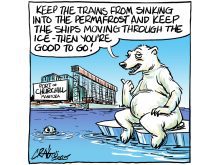WHEN THE federal government allowed railways to abandon old lines, it did more than give up on widespread grain transportation by rail.
It put a huge burden on provinces by forcing them to pay more for grain shipping through upkeep on heavily used roads, and it gave up on the opportunity to use railways for moving people.
That decision may be back t o haunt us.
With oil prices heading back toward $100 per barrel and increasing concern about the environment and reducing emissions, trains seem to be a reasonable way to do short or long distance travel.
Read Also

Topsy-turvy precipitation this year challenges crop predictions
Rainfall can vary dramatically over a short distance. Precipitation maps can’t catch all the deviations, but they do provide a broad perspective.
I’m not thinking about the steam and old trains of the 1950s and 1960s. There are still some of them around and many people remember them with fondness.
I’m thinking of the ac, lighter weight, higher speed trains that operate primarily in Japan and Europe. Many of them are built by Canada’s own Bombardier Inc.
Modern trains are comfortable and generally have more leg room than buses, airplanes or even cars. It’s easy for passengers to get up and stretch their legs without stopping their trip. Seats can be configured to face one another, ideal for family travel.
With trains, unlike airplanes, you don’t have to worry about air turbulence once you’re on your way.
Trains can have snack and drink machines for those who want refreshments or dining cars for long haul.
Today’s lighter trains can easily travel at the same speed as cars or buses.
I’m not expecting anyone to put bullet trains, which travel up to 450 km-h, on branch lines. They may be useful in other situations, like Saskatoon to Regina or Calgary to Edmonton or a main line from Winnipeg to Vancouver via Regina and ssssCalgary. Imagine Winnipeg to Vancouver in roughly eight hours.
We have the technology for an effective passenger rail system in Western Canada using abandoned rail lines, mostly branch lines.
But will this work?
That depends on whether people will reduce their use of cars for long-distance driving. The North American automobile industry is in shambles. Can we get new cars that will make long distance travel comfortable and cost-effective with minimal emissions?
It depends on the federal government’s attitude toward abandoned lines. A law could be put into place to require that, once a railway abandons a line, the right-of-way becomes government property.
The feasibility of using branch lines for passenger service also depends on who, in the government or private sector, will put money into railways. Maybe we could turn old automobile assembly plants into train assembly plants.
The use of trains will depend on the price of tickets and on scheduling.
It may take a while to get people thinking about train travel again. But given our natural and economic environments, it is worth consideration.
Conformable, cost-effective, environmentally friendly trains could be the future for some old prairie branch lines and other lines as well.
Rob Brown is a former agricultural writer and broadcaster now doing studies in ethics. He can be reached at moral.economy@sasktel.net.















